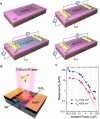2D Materials for Efficient Photodetection: Overview, Mechanisms, Performance and UV-IR Range Applications
- PMID: 35668828
- PMCID: PMC9165695
- DOI: 10.3389/fchem.2022.905404
2D Materials for Efficient Photodetection: Overview, Mechanisms, Performance and UV-IR Range Applications
Abstract
Two-dimensional (2D) materials have been widely used in photodetectors owing to their diverse advantages in device fabrication and manipulation, such as integration flexibility, availability of optical operation through an ultrabroad wavelength band, fulfilling of photonic demands at low cost, and applicability in photodetection with high-performance. Recently, transition metal dichalcogenides (TMDCs), black phosphorus (BP), III-V materials, heterostructure materials, and graphene have emerged at the forefront as intriguing basics for optoelectronic applications in the field of photodetection. The versatility of photonic systems composed of these materials enables their wide range of applications, including facilitation of chemical reactions, speeding-up of responses, and ultrasensitive light detection in the ultraviolet (UV), visible, mid-infrared (MIR), and far-infrared (FIR) ranges. This review provides an overview, evaluation, recent advancements as well as a description of the innovations of the past few years for state-of-the-art photodetectors based on two-dimensional materials in the wavelength range from UV to IR, and on the combinations of different two-dimensional crystals with other nanomaterials that are appealing for a variety of photonic applications. The device setup, materials synthesis, operating methods, and performance metrics for currently utilized photodetectors, along with device performance enhancement factors, are summarized.
Keywords: 2D materials; TMDC; UV-IR photodetectors; black phosphorus; graphene; heterostructures; mechanisms; performance factors.
Copyright © 2022 Malik, Iqbal, Choi and Pham.
Conflict of interest statement
The authors declare that the research was conducted in the absence of any commercial or financial relationships that could be construed as a potential conflict of interest.
Figures


















Similar articles
-
Photodetectors based on graphene, other two-dimensional materials and hybrid systems.Nat Nanotechnol. 2014 Oct;9(10):780-93. doi: 10.1038/nnano.2014.215. Nat Nanotechnol. 2014. PMID: 25286273 Review.
-
Recent Developments of Advanced Broadband Photodetectors Based on 2D Materials.Nanomaterials (Basel). 2025 Mar 11;15(6):431. doi: 10.3390/nano15060431. Nanomaterials (Basel). 2025. PMID: 40137604 Free PMC article. Review.
-
Near-Infrared Photodetectors Based on MoTe2 /Graphene Heterostructure with High Responsivity and Flexibility.Small. 2017 Jun;13(24). doi: 10.1002/smll.201700268. Epub 2017 Apr 11. Small. 2017. PMID: 28398007
-
Mid-Infrared Optoelectronic Devices Based on Two-Dimensional Materials beyond Graphene: Status and Trends.Nanomaterials (Basel). 2022 Jul 1;12(13):2260. doi: 10.3390/nano12132260. Nanomaterials (Basel). 2022. PMID: 35808105 Free PMC article. Review.
-
Development and challenges of polarization-sensitive photodetectors based on 2D materials.Nanoscale Horiz. 2025 Apr 22;10(5):847-872. doi: 10.1039/d4nh00624k. Nanoscale Horiz. 2025. PMID: 39936216 Review.
Cited by
-
Facile hydrothermal synthesis of layered 1T' MoTe2 nanotubes as robust hydrogen evolution electrocatalysts.Front Chem. 2022 Sep 27;10:1005782. doi: 10.3389/fchem.2022.1005782. eCollection 2022. Front Chem. 2022. PMID: 36238098 Free PMC article.
-
Improving the efficiency of dye-sensitized solar cells based on rare-earth metal modified bismuth ferrites.Sci Rep. 2023 Feb 22;13(1):3123. doi: 10.1038/s41598-023-30000-8. Sci Rep. 2023. PMID: 36813815 Free PMC article.
-
Review of Luminescence-Based Light Spectrum Modifications Methods and Materials for Photovoltaics Applications.Materials (Basel). 2023 Apr 15;16(8):3112. doi: 10.3390/ma16083112. Materials (Basel). 2023. PMID: 37109948 Free PMC article. Review.
-
Ternary TiO2/MoS2/ZnO hetero-nanostructure based multifunctional sensing devices.Discov Nano. 2024 Sep 27;19(1):157. doi: 10.1186/s11671-024-04112-7. Discov Nano. 2024. PMID: 39331285 Free PMC article.
-
Impact of Channel Thickness and Doping Concentration for Normally-Off Operation in Sn-Doped β-Ga2O3 Phototransistors.Sensors (Basel). 2024 Sep 7;24(17):5822. doi: 10.3390/s24175822. Sensors (Basel). 2024. PMID: 39275733 Free PMC article.
References
-
- Adhikari K. R. (2017). Thermocouple: Facts and Theories. Himal. Phys. 2017, 10–14. 10.3126/hj.v6i0.18350 - DOI
Publication types
LinkOut - more resources
Full Text Sources
Other Literature Sources
Miscellaneous

